[mashshare]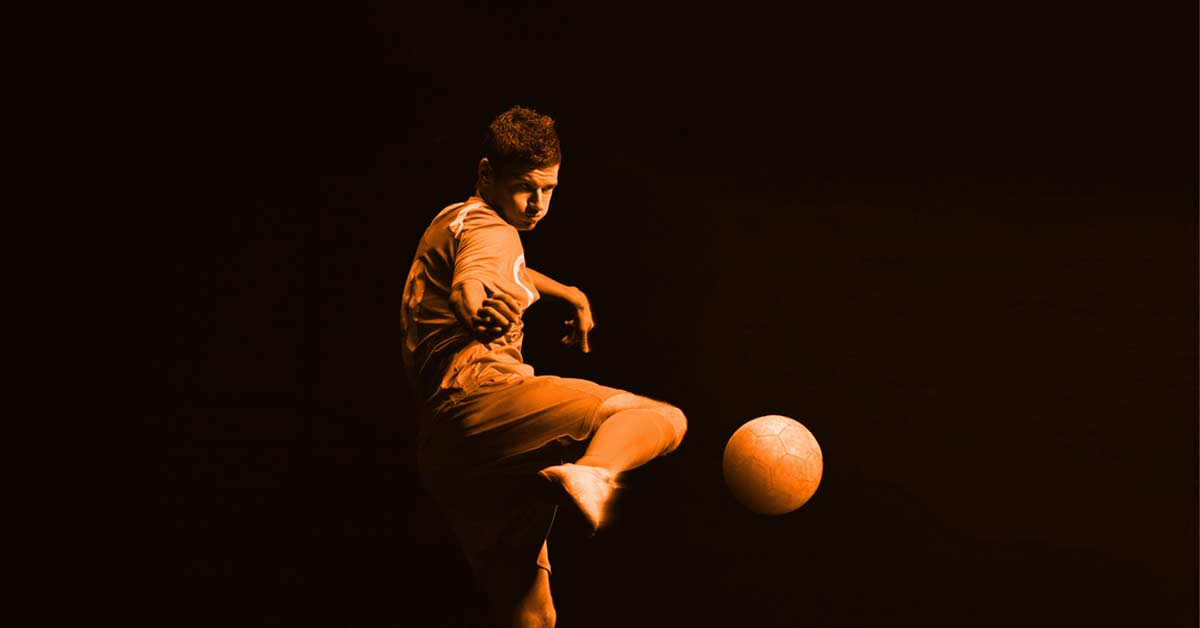
The use of thermography is not new to sport, but more teams and clinics are adopting the technology because of our recent advancements in improving outcomes. Historically, thermography was seen as a promising technique and not a best practice. I have used thermography for years and understand its limitations, but also its potential. Injury reduction and athletic performance improvements in sport are sometimes seen as mirages, but when combined with clinical evaluation, thermography is practical and effective.
ThermoHuman, the company that I am a founder of, is the leader in sports thermography. We have serviced teams and federations for years, and now have clients in the MLB, NBA, and MLS, and individual athletes in the NFL and NHL. The goal of our company, and this article, is to show why thermography is effective, and explain the opportunity to coaches and medical professionals.
What Is Sports Thermography?
Thermography has many names outside of sport, such as infrared thermography and thermal imaging. Professionals have likely seen thermography used in surveillance or other fields like emergency response. Those in sports performance have used thermography to conduct research and help with monitoring athletes though thermal imaging. Sports thermography is an indirect measurement; meaning the camera detects radiation emitted by a body or structure. Human beings are warm-blooded animals, so they are easily monitored with thermogenic images or videos. A recording with thermography is called a thermogram.
We believe that thermograms, combined with clinical evaluation, can help reduce injuries. Share on XSports have used thermography to monitor change with athletes, ranging from exercise responses to injury prevention methods. ThermoHuman believes that, combined with clinical evaluation, thermograms can be used to help reduce injuries before they become problematic. Thermography is not able to predict with certainty that an injury is going to occur, but it can be used in conjunction with other approaches to improve the outcomes of a monitoring program.
Video 1. (In Spanish) Thermography uses infrared cameras to collect athlete data, and then analyzes the information with customized software. Based on the changes in temperature, and on the interpretation, teams can measure patterns of change and make more confident decisions. For non-Spanish speakers, watch the system in action as the information shared on the video is explained in this article.
The human body is a very intricate collection of networks and systems that emit heat, and those temperature changes and fluctuations are clues to possible physiological changes. The radiation of heat can be interpreted with the training to hint at possible issues with function and health status, specifically chronic injury or possible injury risk. A change in skin temperature could just be a normal variance of the human body, or if the pattern matches clinical findings, a possible injury. Most of the research with thermography in sports attempted to connect core temperature with skin temperature and athlete work rates, but over the last few years thermography has seen an increase in medical uses.
What Does ThermoHuman Do?
ThermoHuman is both a software and an education company, not a camera manufacturer. We do use FLIR technology for our customers, but we are interested in figuring out how to interpret the data better and what to do with the data post analysis. Our software is about quantitative change, not interpreting information like sonography or magnetic resonance imaging.
Technically speaking, thickness and sizing information can be found with those technologies, but those imaging techniques are usually preferred to help diagnose an injury using qualitative approaches. ThermoHuman assists professionals by automating the process as much as possible, and educates practitioners on capturing technique along with proper analysis.
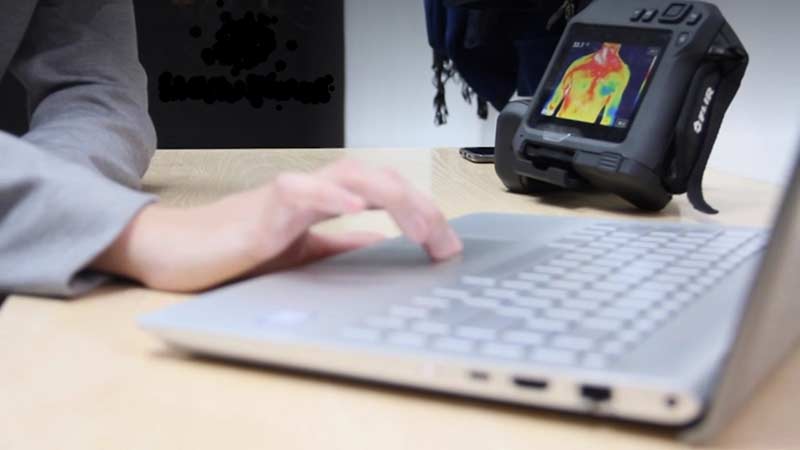
ThermoHuman is a tool for clinicians or very educated support staff, not interns or coaches without education. A thermogram from a camera with our software asks better questions—it doesn’t give comprehensive answers. A thermogram is a representation and summary of heat radiating from an athlete’s body; it’s not a solution that can alert of an injury or weakness directly. Acute pathologies, chronic injuries, and pain perception require clinical evaluation by medical staff, but athlete injuries that are not symptomatic or showing up in functional evaluations are worth exploring with ThermoHuman software and education.
How ThermoHuman Can Help Sports Professionals
ThermoHuman has four effective ways to support player health and performance, and we have seen great success with monitoring and medical divisions of teams. Thermography in sport is still evolving, but it is strongly suited to help the fast-paced environment of world-class sports. Medical staff are mainly concerned with reducing injuries, but when injuries do occur, they want the rehabilitation process to be more effective so re-injury or cascading injury doesn’t strike later.
Thermography is strongly suited to help the fast-paced environment of world-class sports. Share on XInitial assessments are the first step faced by all teams and clinicians. Screening, specifically orthopedic assessment, is useful for documentation but is not always effective for identifying injuries or specific injury risks. Baseline information using ThermoHuman is important for vascular responses, creating an important profile that every professional should have. Vascular defects are complicated matters and should be added to the discussion of player health and wellness.
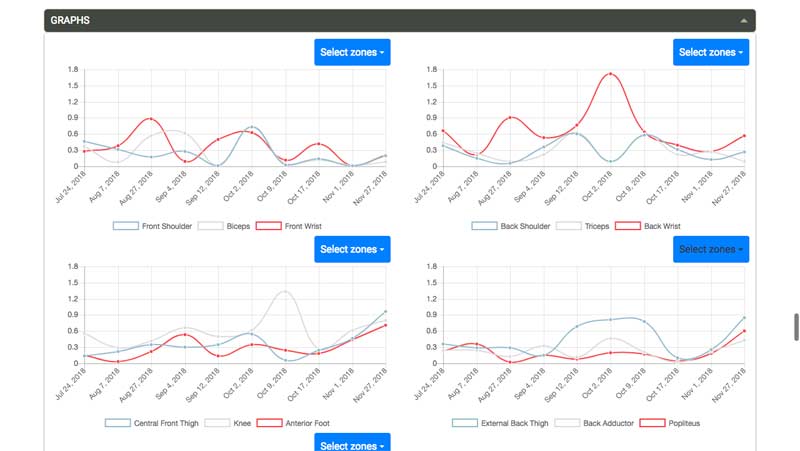
The second area that ThermoHuman excels in is injury management. If an injury does occur, monitoring the advancements in rehabilitation requires a way to track change without even more overloading of the injury site. We do appreciate that muscle performance with strength testing has value in sport clinics, but in combination with thermography the information is even more insightful, such as return from ACL surgery. Tracking a complex injury with an athlete making millions of euros is a very stressful process that requires as much additional information as possible.
Load assimilation is an exciting metric that ThermoHuman specializes in. Player workload is usually very arbitrary, meaning the measurements are not specific to areas of the body. Using the software to add anatomical landmarks enables coaches and medical staff to observe the time course of heavy training and competition during the season. When areas appear to be overloaded, very clear adjustments to sport training or resistance training become easy with our reporting. In combination with GPS tracking and load calculations, we believe that ThermoHuman adds more possibilities to keep athletes training without resorting to resting unnecessarily.
Injury prevention is the final area in which we are seeing growth and success. ThermoHuman is an additional layer that can increase the success rate of injury prevention if used consistently. Asymmetry is a very contextual measure with thermography, since an imbalance requires more than just a comparison between limbs or sides. Having injury history, training information, and other data can explain if an asymmetry is acceptable or if a true concern requires a physiotherapist’s attention. Athletes are able to compensate and manage asymmetries, but over time fatigue and heavy loads result in compromised states that leave an athlete prone to muscle tears or joint injuries.
These four approaches to athlete performance and health improve every year. ThermoHuman is a new company and we are rapidly updating the software as the hardware improves. New research and new methods of athlete support will also shape our software and education, so expect us to continue to refine our technology.
ThermoHuman’s Advantages and Limitations
Sports thermography has a lot of advantages and, of course, limitations. Starting with the drawbacks, you must have training in order to collect the data, and even more training to properly use the information once you collect it from the cameras. The software helps improve the process for organizing the thermographic readings with reporting, but it requires medical expertise to know what to look for. Right now, we only recommend the product’s use in sports medicine and the applied sciences. High-performance coaches should be aware of our system, but the responsibilities of using it will likely be in the hands of the medical division of a team or university.
Its speed in collecting data makes thermography very useful and powerful in sport. Share on XThe speed of data collection is why thermography is so useful and powerful in sport. Within seconds, an image is captured and digitally saved for further analysis. An entire body can be measured in a few minutes and analyzed just as quickly. In addition to the speed of data capture and analysis, the use of sports thermography has further benefits to the user:
- The process is completely non-invasive and painless.
- Thermography is passive—the athlete requires no active effort to collect data.
- Information can be merged with other data streams for cross-validation.
- Data is longitudinal, so trends and patterns can be extracted from the recordings.
Of course, these customer demands are just the tip of the iceberg, but to me they are the foundational directions that lead to the right answers. Like all data and clinical evaluations, cross-referencing other data is suggested to get to the bottom of the problems faced by professionals.
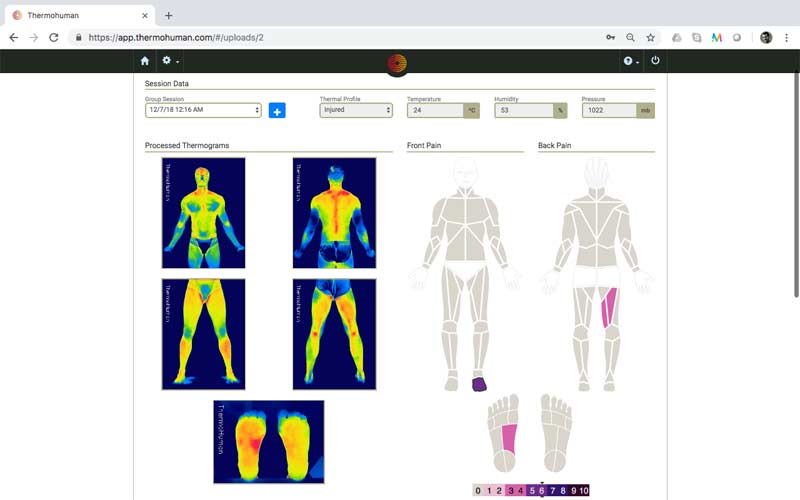
There are limitations with thermography, as it’s not only an indirect measure of body heat, but many of the possible interpretations are indirect as well. Thus, without careful analysis, the use of thermography is extremely limited. If they don’t have the training and clinical skills, practitioners can’t use sports thermography alone.
Other limitations are also environmental, meaning a protocol must adhere to the requirements of proper data collection. Each athlete must remain still and follow instructions or possible artifacts and interference could occur from outside variables. Cameras are more sensitive than a decade ago, but with technical advancements, the process does increase the demand on compliance with end users. Overall, the challenges of thermography should not be an issue for those who adopt the technology, but it’s only fair to warn you that while the benefits are convenience and speed, the method also comes with responsibilities.
Scientific Evidence for Thermography in Sport
A thorough look at the research on thermography does show problems with the interpretation of skin temperature when used as a summary of an athlete’s health status. I want to embrace those limitations again here, with explanations for why the research is sometimes conflicting and difficult to understand. The first step for new users is to understand the science of heat biologically, and then we advance to sports performance and sports medicine.
The first step for new thermography users is to understand the science of heat biologically. Share on XBiologically radiating heat is a natural process that constantly adjusts for internal physiological factors that occur in everyday life. An athlete drinking a cold beverage will change their core temperature, and this may or may not change skin temperature. An athlete with poor circulation of the legs may feel cold, while an athlete of similar build and ability may be sweating. Thermoregulation and physical responses are all unique and each athlete should be seen as an individual being with patterns that are unique.
The validity and reliability of skin temperature with healthy athletes is a question that usually comes up early in conversation. My colleagues and I researched this question and we agree that sometimes readings are problematic, and that’s why our software was designed to manage those conditions. It’s not perfect, but with the mortality risks premature infants face, hospitals are investigating FLIR thermographic cameras as a trustworthy approach to real-time monitoring.
Post training or competition requires a different approach to interpretation, as workload and the response to the strains of exercise add more analysis to the process. Highly trained and untrained athletes respond differently to exercise, and subjective monitoring seems to have a relationship with thermography data as well. Case studies on soccer athletes were useful in explaining the recovery time from practice loads, and repeated monitoring may be a great solution for those that play sports where tracking running isn’t as effective, such as baseball and cricket.
Structural differences in athletes can change work rates and overload patterns, such as the equinus and non-equinus conditions of the foot. A current study with soccer athletes demonstrated how thermography can be used with groups of players to monitor the stress on the gastrocnemius and Achilles tendon. Foot eversion was researched as well with runners, but the relationships were too weak to use as a monitoring solution.
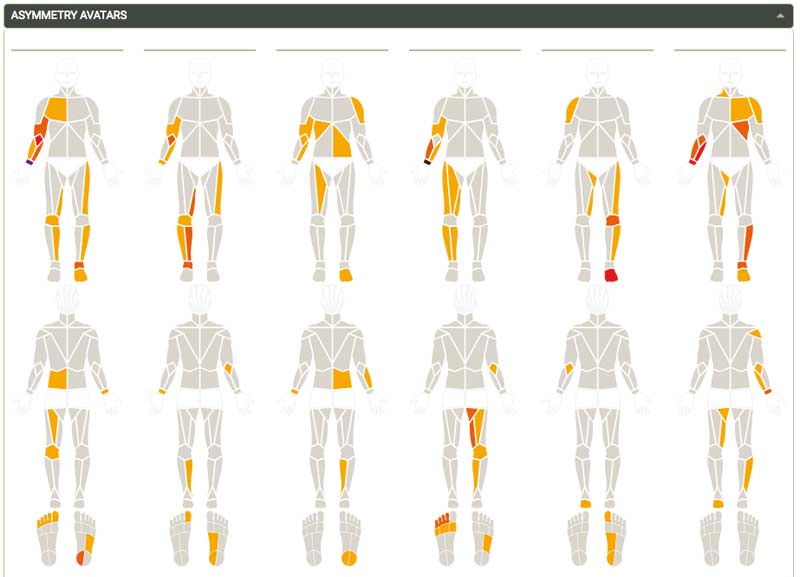
Monitoring chronic and acute injury with thermography is where education transforms the technology into a practical and effective strategy. Pre-scanning athletes when limitations are known is useful, especially when measurements are combined with structural modalities such as traditional medical imaging. ThermoHuman’s goal is to make sports thermography a part of every athlete’s routine. I realize it’s a very small part of the picture, but it’s a real opportunity for teams to reduce injuries. Proper training, comprehensive monitoring, and highly educated staff help a successful team win games and reduce injuries, and thermography fits into the methodology. Each year, sports thermography evolves and improves so that it’s faster, more accurate, and less expensive.
In addition to the above scientific references, I recommend reading these declarations by my colleagues in sports thermography.
How Teams Use ThermoHuman
Teams are implementing ThermoHuman to manage complex situations and administer athlete monitoring with greater precision and speed. The best way to apply ThermoHuman is to have it compliment what your team does and not force it to take over the monitoring process.
A medical device is a tool for practitioners, so the process should only expand with the addition of thermal imaging and not really change much. The right way of using ThermoHuman is to integrate it proactively and commit to the system you find is manageable in the long run. A few teams utilize ThermoHuman to handle very complex injuries, such as athletes who have gone through multiple surgeries, but it’s also powerful for large teams that are young and are relatively healthy. Success with ThermoHuman relies on being organized and having a plan.
Sports thermography is most powerful when it’s used continuously. Share on XThe clinical process of integrating sports thermography benefits teams, as it ensures the performance of a best practice with conventional care, and adds in a second round of athlete examination. An initial assessment is useful, as explained earlier, but sports thermography is most powerful when it’s used continuously. Due to the fact it is visual, it may seem to be in the same category as medical imaging, but that is not the case.
Thermography is, again, quantification of physiological responses, and it’s up to the practitioners to determine if false negatives and false positives are due to confounding variables or the limitations of emitted radiation. A thermogram captured over time reveals how injuries and possible pathologies are trending; it doesn’t diagnose the injury or directly predict risk without interpretation and other information.
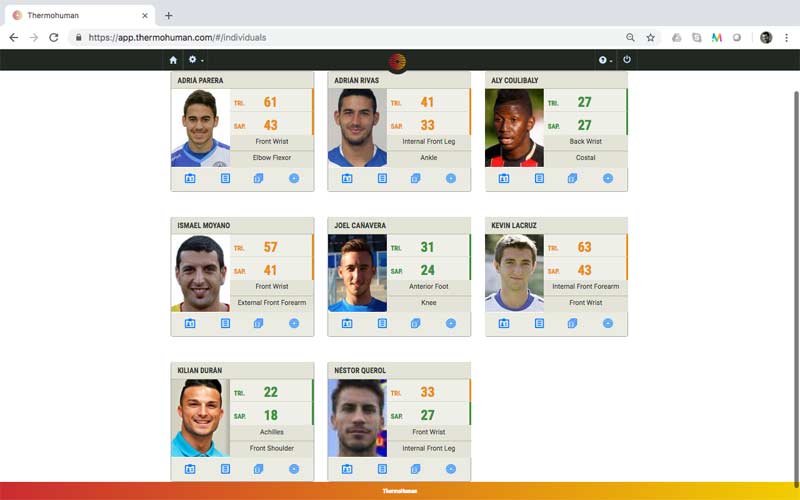
Sport science is using sports thermography to manage workload responses with more resolution for athletes. We support the concept that player tracking and other technologies are excellent for monitoring load. In addition to the collection of data, statistical evaluation of the workload is also proven to be effective in managing risk. Our issue with those methods is that they are very general and non-specific, making them limited in practice.
For example, a body may fatigue in a pattern that can tell us how a program can be altered so an athlete can practice without increasing risk. Another point is that some athletes who are not load-tolerant are usually held back by an injury or past surgery that’s slow to heal. Therefore, summary models of workload are not useful for veteran athletes, or those who are fit overall but managing a small painful condition.
A few users are privately experimenting with ThermoHuman to assist in recovery approaches. While we educate our users, a strength of ThermoHuman is that we also learn from our users, especially those who are successful and finding original ways to use our service. The collective intelligence enables us to expand our reach and refine the process each year.
How to Work with ThermoHuman
We at ThermoHuman welcome questions and discussion about thermography in sport. We also realize that ThermoHuman is not a great fit for everyone, but do believe that every team can benefit from the power and convenience of thermographic imaging on a routine basis. ThermoHuman won’t do the work for you, but it will streamline and improve the process so that precious time and energy can go toward better support of athletes.
My hope is that the biological sciences help improve the capability of thermography in sport. Share on XFor years, we have seen successful outcomes by working with teams that are proactive and patient with our technology. If you are interested in demonstrations, I recommend watching the videos of our system in practice to understand how convenient our solution is. If you are skeptical about the effectiveness, I welcome you to look at the best available science to become familiar with the potential and limitations of thermography. My hope is that the biological sciences help improve the capability of thermography in sport, and ThermoHuman will be ready for those advancements.
Since you’re here…
…we have a small favor to ask. More people are reading SimpliFaster than ever, and each week we bring you compelling content from coaches, sport scientists, and physiotherapists who are devoted to building better athletes. Please take a moment to share the articles on social media, engage the authors with questions and comments below, and link to articles when appropriate if you have a blog or participate on forums of related topics. — SF
[mashshare]



